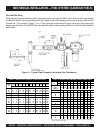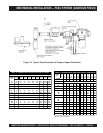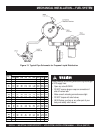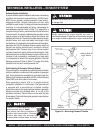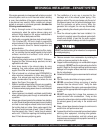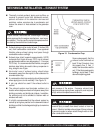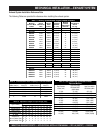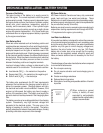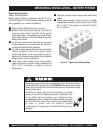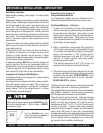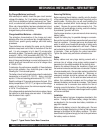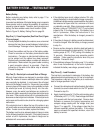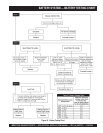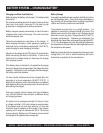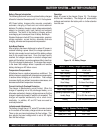
PAGE 50 — INDUSTRIAL GENERATOR SETS — APPLICATION & INSTALLATION MANUAL — REV. #4 (09/07/07)
MECHANICAL INSTALLATION — BATTERY SYSTEM
Purpose of the Battery
The major function of the battery is to
supply current to
start the engine
. The current required to crank the genset
engine varies by model. Cranking current is dependent upon
the engine stroke and bore, the number of cylinders, engine/
starter ratio, circuit resistance, temperature, engine oil
viscosity, and the accessory loads. A four-cylinder engine
could require as much cranking current as an eight-cylinder
engine with greater displacement. All of these factors are
considered when an original equipment battery is specified
by the engine manufacturer.
How Batteries Work
When two unlike materials such as the battery positive and
negative plates are immersed in sulfuric acid (the electrolyte),
a battery is created and a voltage is developed. The voltage
developed depends on the types of materials used in the
plates and the electrolyte used. Electrical energy is produced
by the chemical reaction between the different materials and
the electrolyte. When the chemical reaction starts, electrical
energy flows from the battery as soon as there is a circuit
between the battery positive and negative terminals.
Lead-acid storage battery voltage is determined by the
materials used in its construction. The chemicals used are:
MQ Power Batteries
MQ Power Industrial Gensets use heavy duty commercial
grade, lead acid type, low water-loss batteries. These
batteries do not need to be serviced (such as adding water),
and when properly maintained only need to be replaced after
the pro-rata date (usually 36 months).
Batteries are sized to meet or exceed engine manufacturer's
ampere/hour starting requirements and comply with NFPA-
110 requirements for engine cycle-cranking.
Low Water-loss Batteries
A low water-loss battery is designed to relieve the consumer
of routine maintenance requirements such as adding water
during the service life of the battery. Low water-loss batteries
produce very little gas at normal charging voltages and,
therefore, the rate of water loss is very low. MQ Power
battery rate of water loss is low enough that the venting
systems can be completely sealed, except for small vent
holes, and water additions are not necessary for the life of
the battery.
The advantages of low water-loss batteries when compared
to conventional batteries are:
z
Do not require servicing
z
Do not require activation and boost-charging prior to
installation
z
Greater overcharge resistance
z
Reduced terminal corrosion
z
Elimination of overfilling and possible addition of harmful
impurities
When replacing a genset
battery, a battery at least
equivalent to, and preferably
greater than the original battery
ratings is recommended.
NOTE
The battery also supplements the DC load requirements
whenever the load excess the charging system's ability to
deliver the necessary power. Charging systems will carry
the electrical load under normal conditions. However, if the
engine is at idle speed, the battery may have to supply a
portion of the accessory load. The battery must supply the
genset's electrical load requirements if the charging system
fails.
The battery can also act as a voltage stabilizer in the charging
system. Occasionally, very high transient voltages are
generated in the electrical system. This may occur in the
making or breaking of a circuit in the system. The battery
partially absorbs and reduces these peak voltages, thereby
protecting solid-state components from damage.
z
Lead dioxide (PbO
2
) — the material on the positive
z
Sponge lead (Pb) — the material on the negative grid
z
Sulfuric acid (H
2
SO
4
) — the electrolyte



